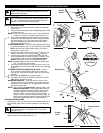
9
OPERATING INSTRUCTIONS
NOTE: Make sure you have a firm grip on the unit. The spinning
blade will contact the ground before the wheel does and
will create continuous forward thrust.
4. Walk slowly behind the unit while maintaining a firm grip on the unit.
TIPS FOR BEST EDGING RESULTS
• Do not force the edger. Edge the first time at a lesser depth,(No
more than 1/2” depth cut per pass), then do the area again with a
deeper setting.
• Walk the edger at a slow, even pace.
• Check the blade condition. As it wears it becomes smaller, thus
reducing the cutting depth performance. Replace with a new blade
when the blade has worn to the blade’s wear limit holes (Fig. 18).
ADJUST BELT TENSION
If blade fails to turn when the bail is pulled, then:
1. Locate small thumb wheel on top of the belt housing (Fig. 17).
2. Turn the wheel clockwise 1 revolution to increase the tension
on the belt.
3. Try pulling the bail and see if the blade turns. If not, repeat step
2 until the blade turns.
MAINTENANCE AND REPAIR INSTRUCTIONS
HOLDING THE UNIT
Before operating the unit, stand in the
operating position (Fig. 16). Check for the
following:
• The operator is wearing eye protection
and proper clothing.
• Both hands are holding the handle bar
firmly.
• The edger wheel adjusted for proper
cut depth as shown in Figure 17 and
edger positioned as shown in Fig. 16.
ADJUSTING EDGER CUTTING DEPTH
1. Grasp the depth adjustment lever
located beside the front wheel (Fig. 17).
2. To raise the cutting blade, move the
lever toward the front of the wheel
bracket (Fig. 17).
3. To lower the cutting blade, move the
lever toward the rear of the wheel
bracket.
OPERATING THE UNIT
Once the unit has started:
1. Tilt the unit back until
the blade is not in
contact with the
ground.
2. Lift the bail (Fig. 16)
and hold it against the
unit’s handle to
engage the blade and
keep it rotating.
3. Slowly lower the unit
until the front wheel is
in contact with the
ground.
Fig. 16
Fig. 18
Blade Edges
Wear Limit
Holes
WARNING:
Always wear
eye, hearing, foot and body
protection to reduce the risk of
injury when operating this unit.
WARNING:
To prevent serious injury, never perform
maintenance or repairs with unit running. Always service
and repair a cool unit. Disconnect the spark plug wire to
ensure that the unit cannot start.
Perform these required maintenance procedures at the frequency
stated in the table. These procedures should also be a part of any
seasonal tune-up.
NOTE: Some maintenance procedures may require special tools or
skills. If you are unsure about these procedures take your
unit to a Sears or other qualified service dealer.
NOTE: Maintenance, replacement, or repair of the emission control
devices and system may be performed by a Sears or other
qualified service dealer.
In order to assure peak performance of your engine, inspection of
the engine exhaust port may be necessary after 50 hours of
operation. If you notice lost RPM, poor performance or general lack
of acceleration, this service may be required. If you feel your engine
is in need of this inspection, refer service to a Sears or other
qualified service dealer for repair. DO NOT attempt to perform this
process yourself as engine damage may result from contaminants
involved in the cleaning process for the port.
FREQUENCY MAINTENANCE REQUIRED SEE
Before using
Fill fuel tank with fresh fuel
Check Oil
p. 7
p .10
Every 10 hrs Clean and re-oil air filter p. 10
After 1st 10 hrs
After 25 hrs & Every 25 hrs
Every 50 hrs
Change Oil
Change Oil
Clean Spark Arrestor
p. 10
p. 10
p. 12
Every 10 hrs
Every 25 hrs
Every 25 hrs
Check rocker arm to valve clearance and adjust
Check rocker arm to valve clearance and adjust
Check spark plug condition and gap
p. 11
p. 11
p. 12
• MAINTENANCE SCHEDULE •
Lift
Bail
Fig. 17
Thumb
Wheel
Wheel
Bracket
Depth
Adjustment
Lever


















